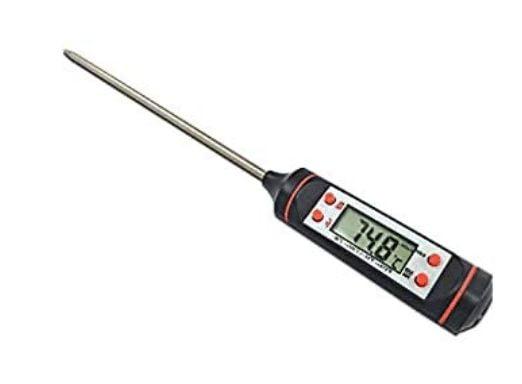DIGITAL THERMOMETER (COST: RS.450/PIECE)
₹450.0
Check the temperature of the compost pile.
Range -50 to +300 degree Celcius
LR44 battery powered
Check temperature of your compost pile while in cooking
stage and curing stage
Accurate Digital Thermometer:
Embracing eco-friendly products transforms waste into wealth, fostering sustainability and mitigating environmental impact. Innovative initiatives champion the conversion of discarded materials into valuable resources, paving the way for a circular economy.
To commence this virtuous cycle, recycling emerges as a key player. Plastics, paper, and metals, once destined for landfills, undergo a metamorphosis. These materials are reimagined, reincarnated into new products, reducing the demand for virgin resources and curbing pollution.
Biodegradable alternatives further revolutionize our consumption patterns. Products derived from natural materials seamlessly integrate into the ecosystem, leaving minimal traces. This shift not only reduces the burden on landfill sites but also curtails the persistence of harmful substances in the environment.
In the realm of waste-to-wealth, upcycling emerges as a creative force. Discarded items find a second life, elevated into functional and aesthetically pleasing artifacts. From repurposed furniture to fashionable accessories, upcycling not only minimizes waste but also showcases the beauty of sustainable design.
In the business landscape, companies increasingly adopt a cradle-to-cradle approach. This entails designing products with their end-of-life in mind, ensuring that materials can be easily disassembled and reused. Such practices not only enhance resource efficiency but also cultivate a mindset of responsibility within the industry.
Accurate Digital Thermometer : The waste-to-wealth paradigm extends beyond tangible goods to energy production. Biomass, a byproduct of organic waste, becomes a valuable energy source through anaerobic digestion or incineration, contributing to the renewable energy matrix.
In conclusion, the transition to eco-friendly products and the waste-to-wealth philosophy signifies a revolutionary stride towards a sustainable future. By reimagining waste as a valuable resource, society not only mitigates environmental harm but also forges a path toward a regenerative and harmonious relationship with the planet.
You must be logged in to post a review.
Q & A
Sustainability of a Digital Thermometer
Energy Efficiency:
- Low Power Consumption: Digital thermometers typically use very low power, often relying on small batteries that last for extended periods. This reduces the demand for energy over the product's lifecycle.
- Energy-Efficient Manufacturing: If the thermometer is manufactured in facilities that use renewable energy sources or have implemented energy-saving practices, this can further enhance its sustainability.
Material Selection:
- Recyclable Materials: Many digital thermometers are made using materials like ABS plastic and electronic components that can be recycled. The use of recyclable materials reduces the environmental impact at the end of the product's life.
- Minimized Use of Hazardous Substances: Sustainable digital thermometers are designed to minimize or eliminate the use of hazardous substances like mercury, lead, and cadmium, which are harmful to both the environment and human health.
Durability and Longevity:
- Long Lifespan: Digital thermometers are generally durable and designed to last several years. A longer lifespan means fewer replacements, which reduces the overall environmental impact associated with production and disposal.
Packaging:
- Eco-friendly Packaging: If the thermometer is packaged using biodegradable or recyclable materials, it further contributes to its sustainability.
Low Carbon Footprint of a Digital Thermometer
Compact Design:
- Smaller Size: The compact size of digital thermometers means they require fewer materials to produce, reducing the overall carbon emissions associated with manufacturing.
- Less Energy Intensive: The production process for smaller devices typically consumes less energy compared to larger, more complex products.
Efficient Manufacturing Processes:
- Advanced Manufacturing Techniques: The use of modern manufacturing techniques, such as automation and precision engineering, can reduce waste and improve energy efficiency, leading to a lower carbon footprint.
Supply Chain Optimization:
- Local Sourcing: If materials and components are sourced locally, it reduces the transportation emissions associated with bringing those materials to the manufacturing site.
- Efficient Distribution: Optimized distribution channels can minimize the carbon emissions related to transportation from the manufacturing site to the end consumer.
Battery Efficiency:
- Low Power Consumption: The use of energy-efficient batteries reduces the frequency of battery replacement, lowering the carbon emissions associated with battery production and disposal.
- Rechargeable Batteries: Some digital thermometers use rechargeable batteries, which have a lower overall environmental impact compared to single-use batteries.
End-of-Life Management:
- Recycling Programs: Many manufacturers offer take-back or recycling programs for old digital thermometers, ensuring that materials are recovered and reused, rather than contributing to landfill waste, which reduces the carbon footprint associated with disposal.
Scientific Explanation
The sustainability and low carbon footprint of digital thermometers are largely attributable to their small size, energy efficiency, and the use of recyclable materials. According to life cycle assessments (LCAs) of similar electronic products, energy consumption during the use phase is typically the most significant contributor to the overall carbon footprint. However, due to the low power requirements of digital thermometers, their use-phase emissions are minimal. Furthermore, advancements in electronics manufacturing, such as energy-efficient semiconductor fabrication and the use of renewable energy in production facilities, further reduce the carbon footprint of these devices.
References & Further Reading
- Life Cycle Assessment (LCA) of Electronic Devices: Provides a comprehensive understanding of the environmental impacts associated with the production, use, and disposal of electronic devices.
- Energy Consumption of Battery-Powered Devices: Discusses the energy efficiency of small electronic devices and their impact on sustainability.
- Recycling of Electronic Components: Explores the benefits of recycling electronic components in reducing environmental impact.
General Inquiries
There are no inquiries yet.



Reviews
There are no reviews yet.